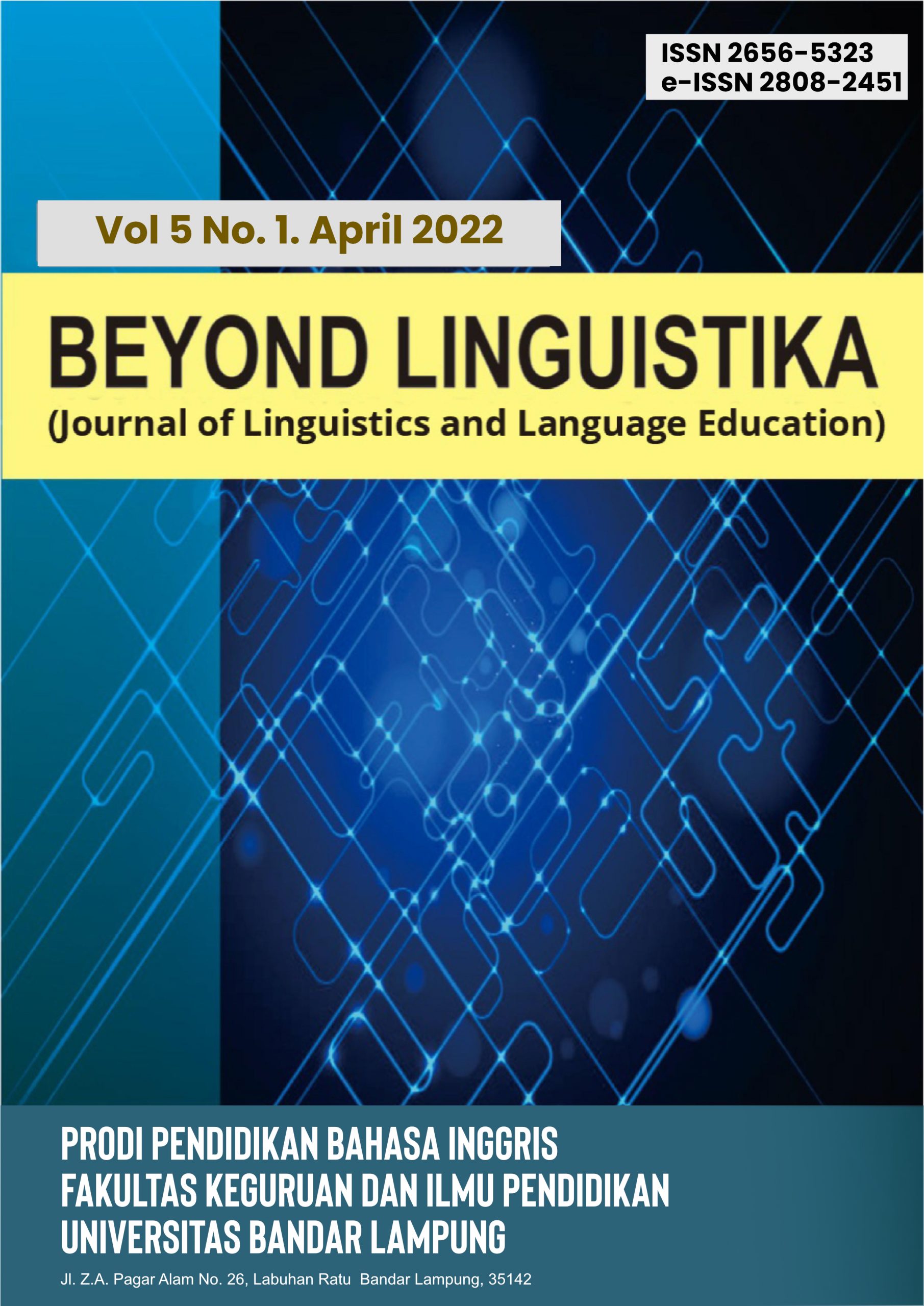Analyzing Mispronunciation Patterns of Alveolar and Velar-Alveolar Consonant Clusters: A Comprehensive Investigation
Abstract
The present study explores the complex realm of pronunciation patterns demonstrated by Indonesian high school students who are engaged in the study of English as a Foreign Language (EFL). The research specifically concentrates on the clusters of alveolar and velar-alveolar consonants. The research endeavours to investigate the fundamental mechanisms that contribute to mispronunciation among learners, drawing upon phonological theories and frameworks of second language acquisition. A group of five high school students from SMA Persada Bandar Lampung, who possess a high level of English proficiency as a result of their extensive early education, were chosen as participants for the study. Their pronunciation of English words containing final alveolar-alveolar and velar-alveolar consonant clusters was thoroughly analysed through group interviews and recording sessions. The utilisation of phonetic transcriptions and error pattern detection has contributed to a more comprehensive comprehension of the impact of the individual's original language on the pronunciation of a second language. The results of the study provide insight into the difficulties encountered by Indonesian English as a Foreign Language (EFL) learners, namely in effectively managing the phonetic differences between English and Indonesian. The study offers useful insights for language education tactics by clarifying these pronunciation issues, hence promoting more efficient language acquisition ways.
Keywords
Full Text:
PDFReferences
Afshari, S., & Ketabi, S. (2016). Current trends and future directions in teaching English pronunciation. International Journal of Research Studies in Language Learning, 5. https://doi.org/10.5861/ijrsll.2016.1437
Derwing, T. M., & Rossiter, M. J. (2002). ESL learners’ perceptions of their pronunciation needs and strategies. System, 30(2), 155–166. https://doi.org/https://doi.org/10.1016/S0346-251X(02)00012-X
Grabe, W. (2007). English, information access, and technology transfer: A rationale for English as an international language. World Englishes, 7, 63–72. https://doi.org/10.1111/j.1467-971X.1988.tb00215.x
Indrayadi, T., Daflizar, D., Irawan, Y., & Helty, H. (2021). Indonesian EFL Students’ Difficulties in Recognizing English Letters. The Qualitative Report. https://doi.org/10.46743/2160-3715/2021.4846
Irawan, Y., Ayunda, D., & Kurnia, N. (2023). Proficiency and Error of English Final Consonant Cluster Pronunciation Produced by Sundanese Students. Jurnal Kependidikan: Jurnal Hasil Penelitian Dan Kajian Kepustakaan Di Bidang Pendidikan, Pengajaran Dan Pembelajaran, 9, 645. https://doi.org/10.33394/jk.v9i2.7743
Kosasih, M. M. (2021). Factors Affecting Indonesian Students in Learning English Pronunciation. International Research in Higher Education, 6(3), 13. https://doi.org/10.5430/irhe.v6n3p13
Levis, J., Sonsaat, S., Link, S., & Barriuso, T. (2016). Native and Nonnative Teachers of L2 Pronunciation: Effects on Learner Performance. TESOL Quarterly, 50. https://doi.org/10.1002/tesq.272
Li, F. (2016). Contrastive Study between Pronunciation Chinese L1 and English L2 from the Perspective of Interference Based on Observations in Genuine Teaching Contexts. English Language Teaching, 9, 90. https://doi.org/10.5539/elt.v9n10p90
Liang, D. (2015). Chinese Learners’ Pronunciation Problems and Listening Difficulties in English Connected Speech. Asian Social Science, 11. https://doi.org/10.5539/ass.v11n16p98
Mahmood, A., & Jamal, L. (2017). ESP Need Analysis: A Study of English Language Learning of Business Students Keyword-English for Specific Purpose (ESP); Language for Specific Purposes (LSP). In Journal of English Language and Literature (Vol. 8, Number 2).
Moedjito. (2016). The Teaching of English Pronunciation: Perceptions of Indonesian School Teachers and University Students. English Language Teaching, 9, 30–41. https://api.semanticscholar.org/CorpusID:54912352
Moedjito, Jaelani, S. R., & Asrobi, M. (2019). What makes EFL speakers’ utterances more intelligible in the context of global intelligibility? Indonesian Journal of Applied Linguistics, 9(1), 157–166. https://doi.org/10.17509/ijal.v9i1.15235
Munro, M., & Derwing, T. (2006). The functional load principle in ESL pronunciation instruction: An exploratory study. System, 34, 520–531. https://doi.org/10.1016/j.system.2006.09.004
Munro, M. J., & Derwing, T. M. (1995). Foreign Accent, Comprehensibility, and Intelligibility in the Speech of Second Language Learners. Language Learning, 45(1), 73–97. https://doi.org/https://doi.org/10.1111/j.1467-1770.1995.tb00963.x
Nkhi, S., & Lebona, T. (2023). Challenges Encountered by ESL Students in The Development of Communicative Competence Skills in Lesotho. International Journal of Language and Literary Studies, 5. https://doi.org/10.36892/ijlls.v5i2.1229
Noviyenty, L., & Putri, M. (2021). Mother Tongue Interference Towards Students’ English Pronunciation: A Case Study in IAIN Curup. Proceedings of the International Conference on Educational Sciences and Teacher Profession (ICETeP 2020), 283–290. https://doi.org/10.2991/assehr.k.210227.049
Nurjamin, L. (2020). The Priorities of English Pronunciation Elements for Indonesian Junior High School Students. English Education and Applied Linguistics Journal (EEAL Journal), 3, 16–21. https://doi.org/10.31980/eealjournal.v3i1.850
Pallier, C., Colomé, A., & Sebastián-Gallés, N. (2001). The Influence of Native-Language Phonology on Lexical Access: Exemplar-Based Versus Abstract Lexical Entries. Psychological Science, 12(6), 445–449. https://doi.org/10.1111/1467-9280.00383
Panggua, S., Wello, B., Jabu, B., & Macdonald, D. (2017). Self-Assessed Professional Competence of the High School EFL Teachers in Toraja Indonesia. International Journal of English Linguistics, 8, 25. https://doi.org/10.5539/ijel.v8n2p25
Ishaq, R. K. M. (2018). English Education Reform in Arab World. US-China Foreign Language, 16(3). https://doi.org/10.17265/1539-8080/2018.03.003
Rodriguez, G., Cawili, A., & Puyoc, E. (2020). Variation of Pronouncing Cultural Words of Biga, Tongrayan, and Limos Groups in Kalinga, Philippines. International Journal of English Literature and Social Sciences, 5, 2575–2584. https://doi.org/10.22161/ijels.56.97
Sahiruddin, S., Junining, E., & Prawoto, S. (2020). The Implementation of English as A Medium of Instruction in An Indonesian EFL Setting. Proceedings of the Brawijaya International Conference on Multidisciplinary Sciences and Technology (BICMST 2020), 205–208. https://doi.org/10.2991/assehr.k.201021.048
Sakhiyya, Z. (2019). English as a Lingua Franca: Perspectives for English language teaching and for teacher education. Proceedings of the UNNES International Conference on English Language Teaching, Literature, and Translation (ELTLT 2018), 117–119. https://doi.org/10.2991/eltlt-18.2019.24
Scarcella, R. C., & Oxford, R. L. (1994). Second language pronunciation: State of the art in instruction. System, 22(2), 221–230. https://doi.org/https://doi.org/10.1016/0346-251X(94)90058-2
Soomro, A. (2018). Pedagogical Practices Employed in Teaching and Learning Speaking Skills at Taif University. International Journal of English Linguistics, 8, 273. https://doi.org/10.5539/ijel.v8n4p273
Zein, S., Sukyadi, D., Hamied, F., & Lengkanawati, N. (2020). English language education in Indonesia: A review of research (2011–2019). Language Teaching, 53, 1–33. https://doi.org/10.1017/S0261444820000208
Zhou, Q., Li, Y., & Guo, L. (2020). Guidance of Computer-aided Self-teaching and Practice of English Pronunciation for Chinese Adult English Learners. Journal of Physics: Conference Series, 1453, 012077. https://doi.org/10.1088/1742-6596/1453/1/012077
DOI: http://dx.doi.org/10.36448/bl.v6i2.3584
Refbacks
- There are currently no refbacks.















